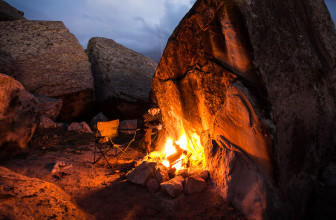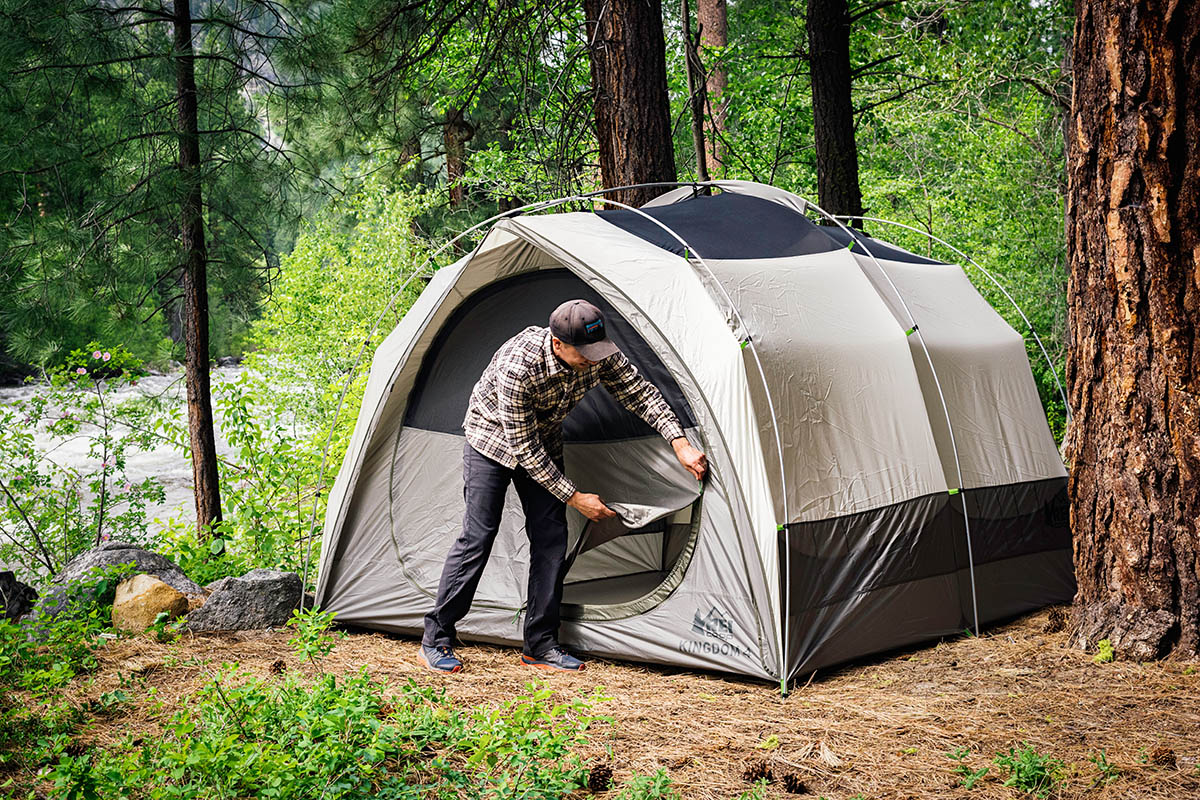
Camping tents are made for just that, camping, not for surviving a howling, week-long gale on the South Col of Everest. As such camping tents are designed first and foremost to be roomy and comfortable. They should also be relatively affordable, water resistant, easy to transport, and easy to set up.
The best camping tents for families can typically accommodate anywhere from 2 to 8 people with headroom that ranges from good to ridiculous. And while they should be able to withstand the occasional rainy day, they aren’t built for bad weather.
The camping tent is the tent you take when you’re headed to the state park for a summer weekend with family and friends and most are not used more than a few times a year.
As such even camping tents at the lower end of the price spectrum should last you many years as long as the build quality is reasonable. Here complete your camping kit with the Camping chairs and the backpacking tents for the camping on trail.
Our Top 10 Camping Tents For Families are
Without further ado let’s get right into our choice of the best tents to take camping.
-
Marmot Halo 6-Person Camping Tent
Where the Marmot Halo separates itself from the pack is in its 4 pole construction that allows it to withstand higher winds than most large tents. The Halo has an 81-inch peak which easily accommodates even 6+ footers. The Halo also features outstanding ventilation, excellent rain resistance, easy access, and easy to set up and take down.
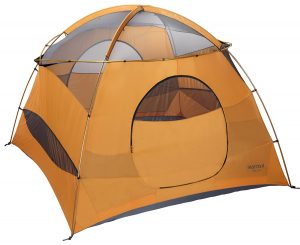 Pros
Pros
- Outstanding wind resistance
- All the headroom you could want
- Two doors for easy access and egress
- Durable, full-coverage fly
- Fast, intuitive setup
Cons
- Uninspiring design
Verdict
The Marmot Halo 6 Person Camping Tent won’t blow you away with its design but it will let you set up the card table inside and play well into the night while the brook is babbling in the distance. Besides the outstanding interior room, the Halo also needs to be commended for its water resistance, which is among the best of all consumer-grade, large camping tents.
-
Sundome 6 Person Tent
Coleman outdoor products are nothing if not practical and the Sundome is no exception. It features predictably good Coleman build quality and nice practical touches like the electrical access port and Insta-clip poles. Like many other Coleman products, it’s also remarkably affordable and has that unmistakably solid look and feel to it.
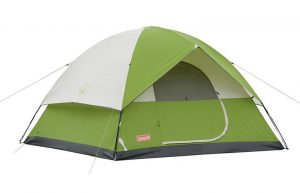 Pros
Pros
- Reasonably priced
- 100 square feet of interior space
- Easy setup and take-down
- Plenty of room for 5 or 6
- Fire retardant fabric
Cons
- Feels a bit cramped when standing
Verdict
The Sundome by Coleman is a reliable family camping tent that sets up easily and has plenty of floor space for up to 5 or 6. The floor is well-constructed to keep moisture out and the electrical access panel is an interesting and unexpected plus. When you’re done the whole thing packs down nice and neat for easy storage.
-
Kelty Yellowstone 4 Person
The Kelty Yellowstone is an affordable camping tent for those who want to enjoy comfort and convenience in the outdoors. It can be easily set up by one person, has a generous size door and plenty of ventilation and its classic X structure makes it stable in the wind. The waterproof flooring is a nice touch and the rain fly is effective and durable.
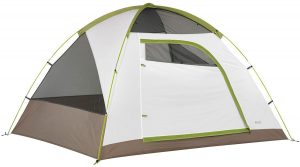 Pros
Pros
- Sets up fast and easy
- Light enough to be carried into the woods
- Extremely stable
- A great value
Cons
- The zippering system on the door isn’t great
Verdict
There are plenty of families out there that would benefit from the affordable quality of the Kelty Yellowstone. It’s not a tent you’re going to take on a Himalayan expedition but it will serve you well for the 4th of July weekend at the state park or your summer fishing trip to Alaska.
-
Eureka Copper Canyon 6 Person
The Copper Canyon 6-Person Tent is your home away from home in the great outdoors. With 7’ of head clearance, 6 poles to keep it nice and stable in the wind, an extremely easy setup for such a large tent, and a very sharp appearance it’s a convenience winner. It’s also a value winner because it costs less than half what some other, inferior tents of equal size cost.
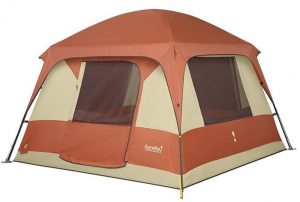 Pros
Pros
- Electrical access port
- Enough space for a card party
- Lots of ventilation
- Incredibly easy setup
Cons
- Not a lot of storage pockets
Verdict
When you consider how large, well-built, and easy to set up this tent is and then you combine all that with its low price you may wonder why you ever considered any other large camping tent for your family outings. It’s hard to argue against the Eureka Copper Canyon.
-
Nemo Bunaglow 4 Person
The Nemo Bungalow 4-Person tent has an unusual profile that tends to grow on you after a while. It’s not as large as some other camping tents but it’s solid as a rock and will keep you warm and dry when the rain sets in. It has a large vestibule, 2 doors, and plenty of pockets for stashing your gear. The glow-in-the-dark guy wires are also a big plus safety-wise.
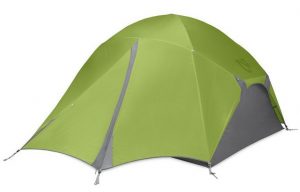 Pros
Pros
- Full coverage fly
- Plenty of room in the vestibule
- Overhead light pockets
- Well made
Cons
- Maybe more than some want to spend
Verdict
The Nemo Bungalow is a forward-looking tent that will grow on you quickly due to its many useful, convenient features. There’s not a lot of headroom though so keep that in mind. Otherwise, it’s a well-constructed camping tent that will last for many years.
-
Coleman Red Canyon 8 Person
The Coleman Red Canyon 8-Person tent provides family campers with plenty to like. There’s 170 square feet of floor space, plenty of room for storage, it’s nice and stable in the wind and it won’t cost you an arm and a leg. The Red Canyon can also be divided into 3 separate interior rooms which has a lot to do with the unusual profile.
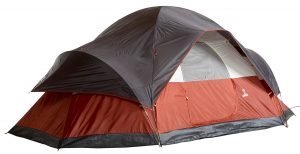 Pros
Pros
- If you need more space it’s time for an RV
- Surprisingly simple to set up
- Reliable Coleman quality
Cons
- Very low clearance at the ends
Verdict
If you’re looking for a large, affordable, easy-to-set-up tent for your next family getaway you’d do well to consider the Coleman Red Canyon. The ability to divide the interior space into 3 “rooms” is a big plus if the kids are a bit older and the whole thing is nice and easy on your wallet.
-
Big Agnes Flying Diamond Tent
The Big Agnes Flying Diamond is another large tent whose internal space can be divided into separate rooms. It’s a good-sized tent but you’re not going to find tons of headroom here. What you will get is stability, rain resistance, lots of horizontal space and plenty of storage pockets throughout for all your various camping gear and tech.
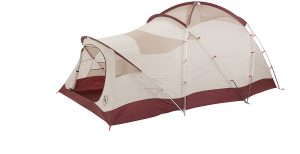 Pros
Pros
- Plenty of space to stretch out
- Effective rain protection
- Stable in the stiffest wind
- Lots and lots of pockets
Cons
- Maybe a bit pricey for some
Verdict
The Flying Diamond 6-Person tent is a well-built, horizontally spacious camping tent that provides an extremely comfortable sleeping platform for the family. We also love the generous number of storage pockets along with the high degree of weather resistance.
-
Kelty Ridge 4 Person
The Kelty Ridge 4-Person tent is deceptively spacious and looks like just another dome but has room for the whole family. The walls are nearly vertical which really allows you to get the most out of the available floor space and the floor has fully taped seams to keep the water out. With 2 big vestibules and lots of ventilation, it’s a hard tent to say ‘no’ to.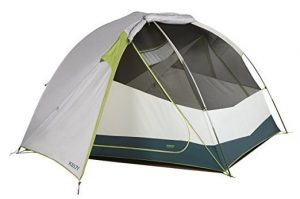 Pros
Pros
- Remarkably easy to set up
- Lots of vertical as well as horizontal space
- Keeps you nice and dry in the rain
- Light for such a big tent
Cons
- Not great in a strong breeze
Verdict
The Kelty Trail Ridge is an excellent value in that it gives you plenty of space, is easy to set up, is light enough to be ported well into the woods if you wish, and provides decent to good rain coverage.
-
MSR Pappa Hubba NX 4 Person
With 5 poles the Pappa Hubba NX seems like you’d need a pretty thick instruction manual to put it together but that’s not the case. And once erected it stays put which makes it a great tent for taking into slightly more challenging terrain. It’s also light so it won’t be a problem carrying it and it’s affordable so it won’t drain your bank account.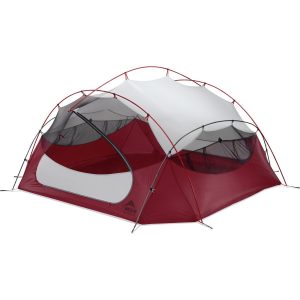 Pros
Pros
- Lots of mesh for excellent ventilation
- Plenty of floor space to stretch out
- Rainfly is easy to install and effective
- A good-looking tent
Cons
- Not a lot of headroom
Verdict
While the Pappa Hubba NX is not as large as some of the other camping tents on this list it’s big enough for a couple and their kids or 3 adults. It’s light and easy to pack, stable as all get out, and will serve you well when the weather gets close.
-
Coleman 6-Person Instant Cabin
Tall, wide, and stable the Instant Cabin is a great platform for long summer vacations by the sea or in the national park. It’s not going to blow you away with its innovative feature set and it’s not supposed to. It’s supposed to provide lots of comfy space and it does that well.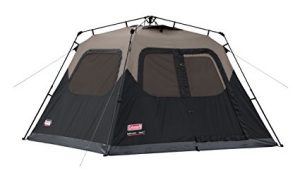 Pros
Pros
- Easily assembled by 1 adult
- Plenty of headroom for the 6 footers
- Lots of ventilation
- Durable bathtub-style floor
Cons
- Few interior storage pockets
Verdict
If you like to sit up after dark socializing in the tent the Coleman 6-Person Instant Cabin is for you. You’ll enjoy plenty of head and leg room, and lots of fresh air, and the whole thing snaps together in about a minute. A great instant cabin for those who really want to relax in the great outdoors.
Categories and Features of Camping Tents
Here is a short primer on the various categories of camping tents.
- Family Camping Tents – Family tents can typically hold 4 to 8 people. Some offer the ability to segment the internal space to create the effect of having 2 or 3 rooms. Family tents are built to withstand rain showers, maybe even the occasional downpour, but are generally too tall to hold up well when the wind starts blowing.
Family tents are not designed to be stowed in a backpack and carted deep into the woods. They’re meant to be taken out of the trunk and set up at the campground.
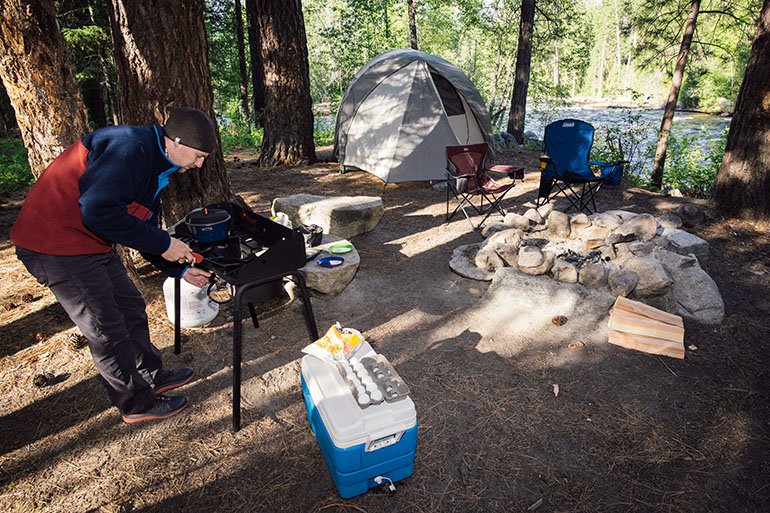
- Cabin Tents – Cabin tents are the biggest of the family tents with some having as much as 8 feet of internal vertical space and as much as 150 square feet of floor space. These are large enough to set up a table and chairs inside so you can enjoy your meals free of bugs or play cards and converse late into the night if you like (campground rules permitting of course).
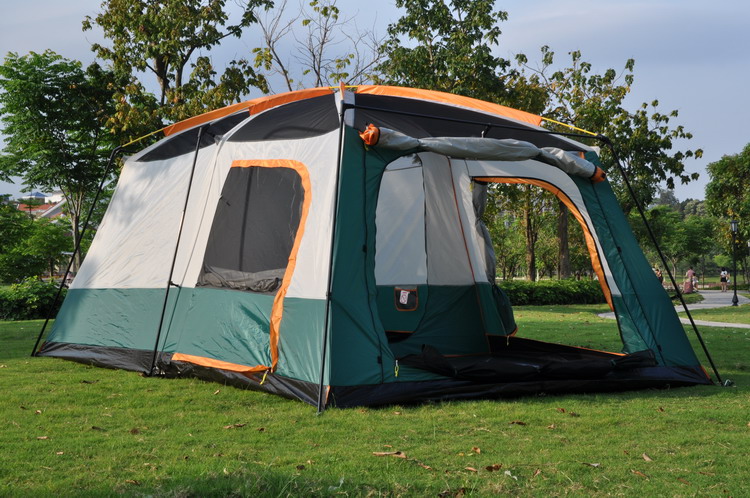
- Dome Tents – The most common form of camping tent the dome tent has been around with few changes for generations. Typically they don’t afford as much vertical space as a cabin tent or some of the larger family tents. Their advantage is that they’re easy to transport, easy to set up, easy on the wallet (most anyway) and they’re stable in the wind.
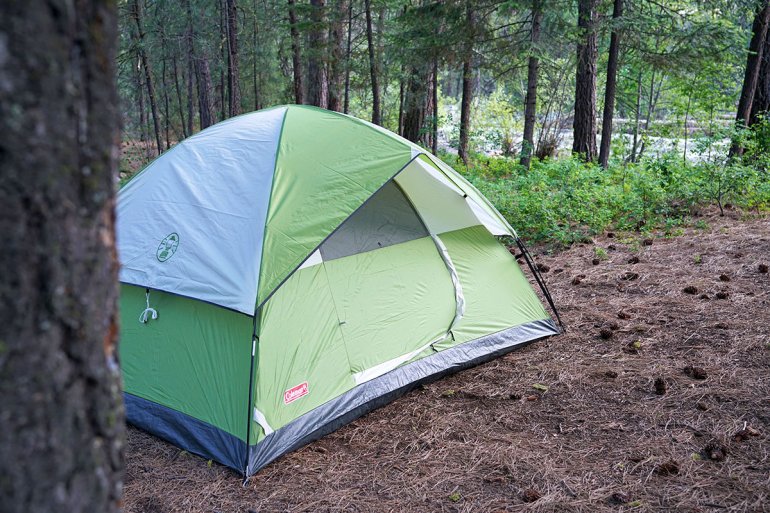
- Popup tents – Setting up a tent can be a chore if you’re tired or the weather isn’t cooperating. For some people too much of a chore. For them, there’s the popup tent. The popup tent is a self-erecting tent that folds down to a relatively small size. It’s then carried into position and, once removed from its carrying case, snaps into place. They’re of limited use on hiking trips but for the state park, they’re a great convenience.
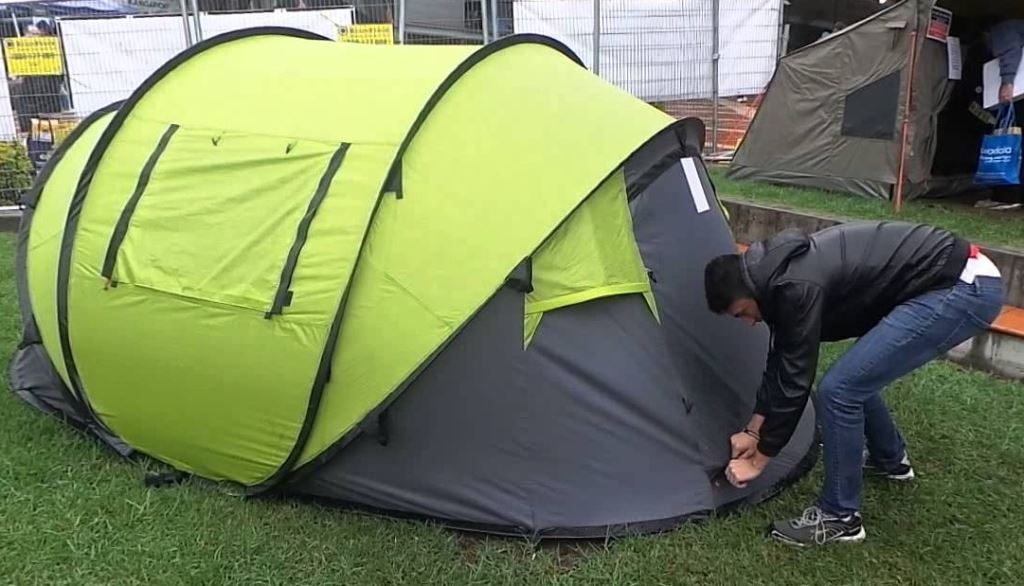
Key Features of the Camping Tent
We touched on some of the most desirable features of a camping tent in our opening but let’s take a moment to look a little closer at some other important camping tent features.
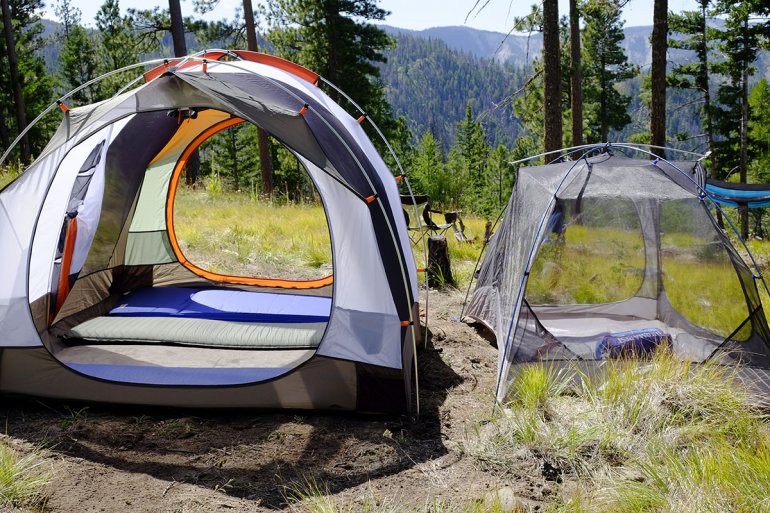
- Vertical space or peak height – If vertical space is important to you don’t just assume the camping tent you have your eye on has 8 feet of interior space. Ask the salesman.
- Floor space – Some tents tout their 100 square feet of floor space. What isn’t said is that a lot of that space is unusable for anything other than stowing gear because the sides of the tent angle in so severely towards the edge.
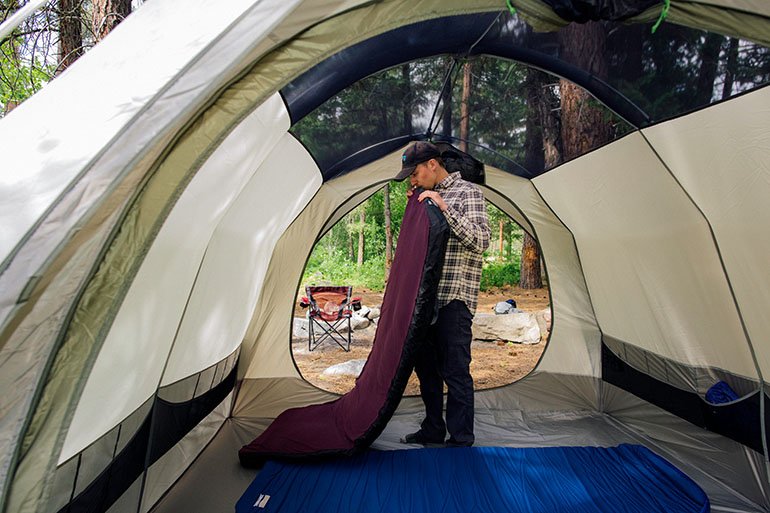
- Doors – Many of the camping tents have both a front and rear door so that people don’t have to stumble over one another to get in and out of the tent.
- The Rainfly – Having a good rainfly is important to staying dry when the bad weather sets in. Without it the tent fabric will quickly become saturated and water will penetrate the tent interior.
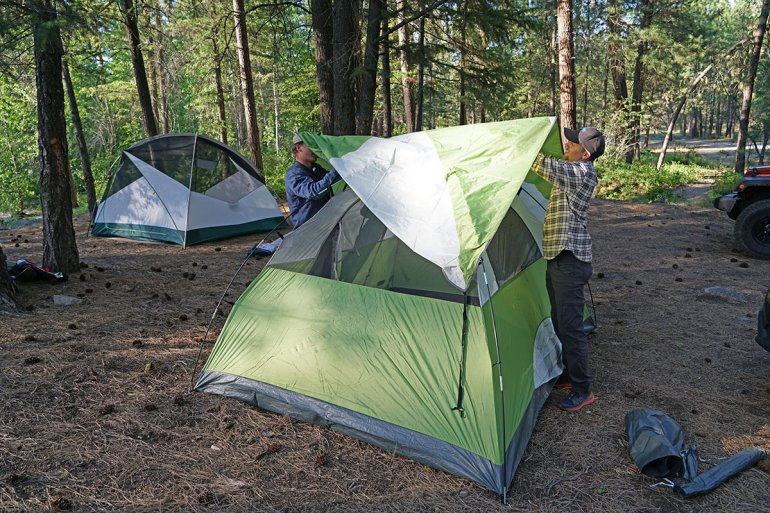
- Storage pockets – A good camping tent will have pockets inside for you to store your camping gear once you settle in for the night.
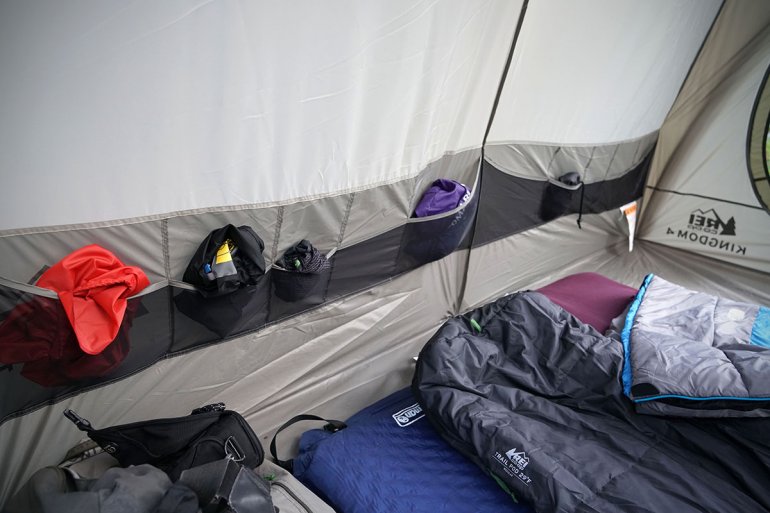
Build Quality of Tents
The best-looking tent isn’t much good if it falls apart in the wind or the seams come undone after only a few uses. Build quality is important and here are a few things to look for:
- Single or double wall – If you’re camping in an area that’s prone to rain you’re going to need a double wall tent. The second wall of the double wall tent is the rain fly and it’s invaluable for most tents in most situations. Single-wall tents are by nature weather tents. And while some will come with the roof only rain fly that isn’t going to be of much help if it rains for a couple of days straight.
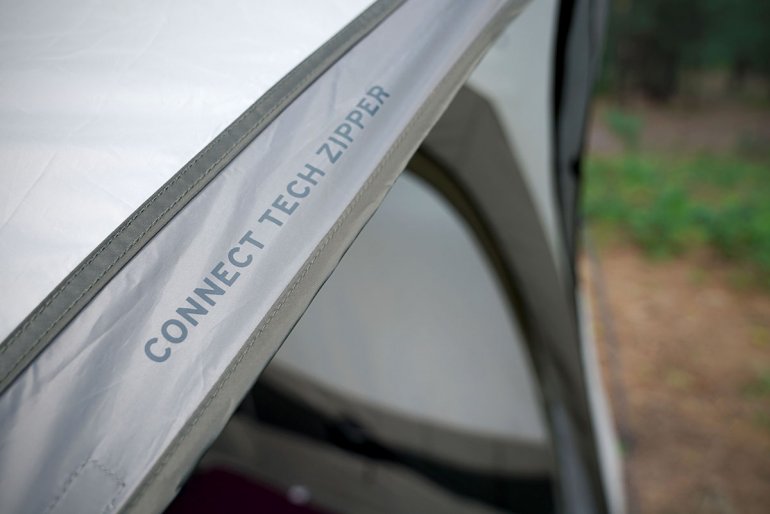
- Tent materials – Tents should be made of denier materials but there are other material considerations beyond that. Here are the most common tent materials in use today:
- Rip-stop nylon: This type of nylon prevents rips and tears from growing until they destroy the tent. If you’re heading into the woods with your tent you’ll want to seriously consider rip-stop nylon.
- Polyester: Polyester tends to withstand UV rays better than nylon. Beyond that, the two materials are pretty much interchangeable.
- Polyethylene: Unless the floor of the tent is made of polyethylene there’s a good chance water is going to seep through when the ground is wet. The whole tent doesn’t have to be made of this material but the floor should be.
- Canvas: Not a material that’s used for camping tents anymore although if you look hard enough you might still be able to find a canvas tent. The advent of lightweight, waterproof materials made the cotton camping tent obsolete.
- UV-Tex 5: This is a very durable fabric that’s among the most resistant to UV degradation. Otherwise, it’s nearly identical to the standard polyester mentioned above.
- Poles – Tent poles today are fabricated from a range of different materials including aluminum, carbon fiber, and fiberglass. Aluminum poles are the most common as they’re light and affordable to make. Carbon fibers are even lighter and tougher than aluminum but they’ll add to the price of the tent. Fiberglass tent poles are probably the best value in tent poles as they’re lighter and tougher than aluminum but not as expensive as carbon fiber.
Things in a Camping Kit
Here are some camping kit essentials everyone should take with them to the campground
- A tactical flashlight – Small, light, and with an intense beam.
- Insect repellent – Unless you like being dinner food for hungry mosquitoes.
- Trash bags – Leaving trash behind in the woods is never acceptable.
- Gloves and a sweater – Weather can change unexpectedly. Be ready.
- Camera – Most people will use the one on their smartphone and that’s fine.
- Waterproof matches – Because you just never know if you’re going to need them.
- First aid kit – Because unfortunately people sometimes get hurt while camping.
- Survival knife – Again because you never know when you might need it.
- Multitool – Because it pays to be ready for just about anything.
Heading into the woods and just assuming everything will be alright is foolish. Always make sure you’re fully prepared by taking along the above items.



